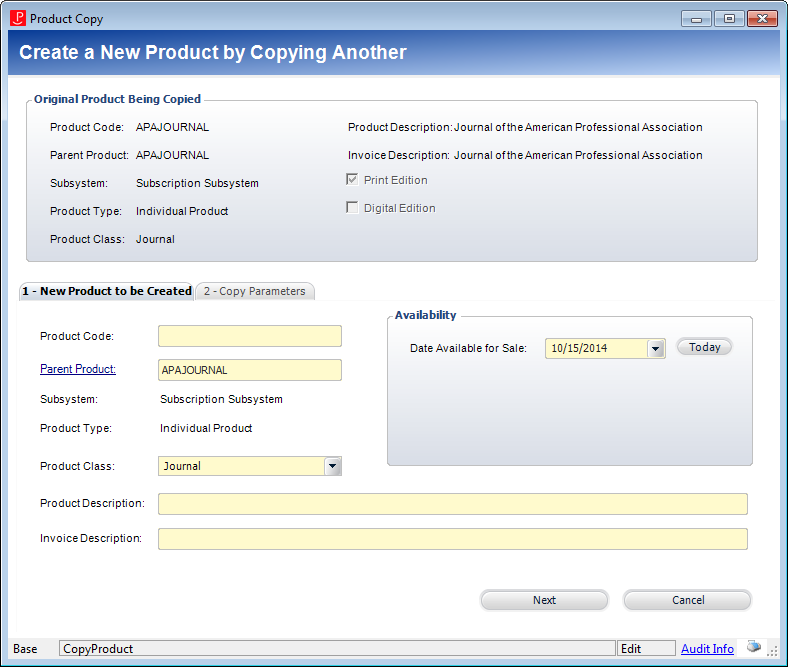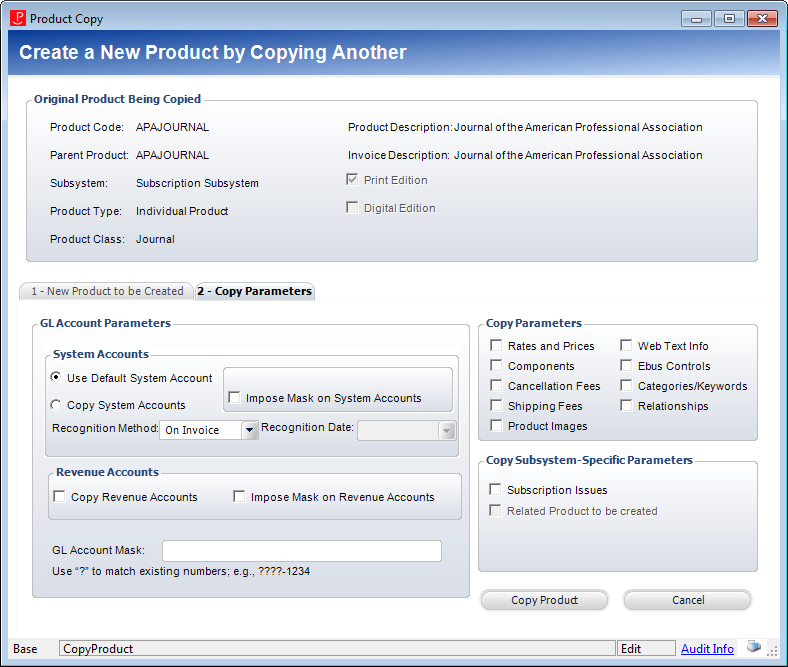Copying a Subscription Product
When you have similar subscription products, copying a product is easier
and less time-consuming than recreating the product.
The Copy Product screen consists of two tabs: New Product to be Created
and Copy Parameters. The New Product to be Created tab is used to set
up the general product information, such as Product Code and Product Type.
The Copy Parameters tab is used to define the parameters that should be
copied from the old product to the new product. When the fields in both
tabs are defined, click Copy Product.
 If
a Renew to this Product has been defined on the Rate
Code Extensions screen, the system will copy the product from the source
product if it is different from the source product. If the renew-as
product is same as the source product, the system will make the renew-as-product
the same as the new product being created.
If
a Renew to this Product has been defined on the Rate
Code Extensions screen, the system will copy the product from the source
product if it is different from the source product. If the renew-as
product is same as the source product, the system will make the renew-as-product
the same as the new product being created.
For example, Product A has a renew-as product of product C. Product A is
copied to product B. The renew-as product for Product B is Product
C. Product A has a renew-as product of Product A. Product A is copied
to Product B. The renew-as product for Product B is Product B.
To copy a subscription product:
1. From the
Personify360 main toolbar, select Products > Product
Central.
The Product Maintenance search screen displays.
2. Click Search
to find a product or click Create New
Product.
3. From the
Related Tasks task category, click Copy this Product.
The Product Copy screen displays, as shown below.

4. On the
New Product to be Created tab, enter the Product Code
of the new product.
 The Product
Code MUST be different from the original product.
The Product
Code MUST be different from the original product.
5. If necessary,
select a new Parent Product.
This value defaults from the original product, but may be changed as needed.
6. Select
the Product Class of the new product.
This value defaults from the original product, but may be changed as needed.
7. Enter
the Product Description and Invoice Description.
8. If necessary,
modify the Date Available for Sale.
This value defaults from the original product, but may be changed as needed.
9. Click
Next.
The Copy Parameters tab displays, as shown below.

10. On the
Copy Parameters tab, select the appropriate radio button in the System
Accounts section.
· Use Default System Account
When selected, the system pulls the Product_Account values from the FGL_Product_Account_Default
table for the subsystem. If this option is selected but no default system
accounts have been defined, then the system accounts for the new product
will be blank.
· Copy System Accounts
When selected, the system copies the Product_Account record from the original
product.
11. If necessary,
check the Impose Mask on System Accounts checkbox.
When checked, you must enter a GL Account Mask
so the system validates that the resulting account exists in the Financial
General Ledger Account Master table. If it does not exist in the table,
then a warning is issued and the user must define these accounts manually.
12. Select
the Recognition Method from the drop-down.
13. Select the Recognition Date from
the drop-down.
Note that this field will be disabled unless “On Specific Date” is chosen
from the Recognition Method drop-down.
14. Check
the appropriate checkboxes in the Revenue Accounts section.
· Copy Revenue Accounts
When checked, the system copies the records from the Product_Revenue_Distribution.
· Impose Mask on Revenue Accounts
When checked, you must enter a GL Account Mask
so the system validates that the resulting account exists in the Financial
and Accounts Receivable system. If it does not exist in the table, then
a warning is issued and the user must define these accounts manually.
15. If you
selected the Impose Mask on System Accounts
or Impose Mask on Revenue Account checkbox(es),
enter the GL Account Mask.
GL account numbers are created with segments that represent the same type
of item for all GL account numbers. You can define the pattern for the
GL account here. For example, the current revenue account is 1-678-4800,
where “4800” is specific to the current product and the revenue account
for the new product is 1-678-4900. Therefore, the GL Account Mask would
be ?-???-4900. When the Impose Mask on System Accounts or Impose Mask
on Revenue Account checkbox(es) are selected and a GL Account Mask is
entered, the system will accept a mask and then update the account based
on this mask. The system must validate that the resulting account is a
valid account.
16. Check
the appropriate checkboxes of the parameters to copy.
The parameters include the following:
· Rates and Prices: defined on the Rates
and Pricing screen.
· Components: defined on the Components
screen.
· Cancellation Fees: defined on the Cancellation
Fees screen.
· Shipping Fees: defined on the Shipping
Charges screen.
· Product Images: defined on the Product
Images screen.
· Web Text Info: defined on the Brief
Description and Long
Description screens.
· Ebus Controls: defined on the eBusiness
Control, Related
Links, Related
Roles, and Search
Engine Optimization (as of 7.6.2) screens.
· Categories/Keywords: defined on the Categories
and Keywords screen.
· Relationships: defined on the Related
Products, Related
Customers, Related
Files, Fundraising
Links, and Product
Segmentation screens.
17. If necessary,
check the Copy Subscription Issues checkbox.
These are the issues set up on the Product
Maintenance> Issue Maintenance
screen.
18. Review
all your fields, and after review, click Copy Product.
If no errors occur, the new product opens on the Product Maintenance screen.
If you receive an error stating, “Another object with the same key already
exists,” return to the “New Product to be Created” tab and make sure you
entered a Product Code different from the original product’s code.
 This process
does not automatically validate the product. You still need to click Validate Setup, as with other product setups,
to finalize the product. For more information, please see Validating
a Product Setup.
This process
does not automatically validate the product. You still need to click Validate Setup, as with other product setups,
to finalize the product. For more information, please see Validating
a Product Setup.
 While the
copy product functionality can copy the web text from the original product’s
e-Business control, you should open the new product’s setup and review
the e-Business to ensure it’s active and appears only when desired.
While the
copy product functionality can copy the web text from the original product’s
e-Business control, you should open the new product’s setup and review
the e-Business to ensure it’s active and appears only when desired.
 If
a Renew to this Product has been defined on the Rate
Code Extensions screen, the system will copy the product from the source
product if it is different from the source product. If the renew-as
product is same as the source product, the system will make the renew-as-product
the same as the new product being created.
If
a Renew to this Product has been defined on the Rate
Code Extensions screen, the system will copy the product from the source
product if it is different from the source product. If the renew-as
product is same as the source product, the system will make the renew-as-product
the same as the new product being created.
